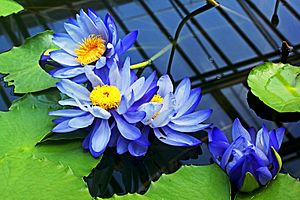Giant waterlily facts for kids
Quick facts for kids Giant waterlily |
|
|---|---|
 |
|
| Scientific classification | |
| Genus: |
Nymphaea
|
| Species: |
gigantea
|
Nymphaea gigantea, also known as the Giant Waterlily or "Blue Cloud," is a beautiful water plant that grows year after year. It's a type of herbaceous plant (meaning it has soft stems, not woody ones) that lives in the water. You can find it naturally in Australia and New Guinea.
This amazing plant is a tropical and sub-tropical species. It grows special underground stems called tubers in the muddy bottoms of calm waters. When its flowers first open, their petals are a light purple-blue. As they get older, they turn a light blue or even white. Because of its lovely blue-white color, it's often called "Blue Cloud." This waterlily usually blooms between June and July.
What Does the Giant Waterlily Look Like?
The leaves of the Nymphaea gigantea are round and can grow very large, up to 75 centimeters (about 30 inches) across! Their edges are wavy and have small, pointed teeth, about 0.5 centimeters long. The tips of the leaf sections are rounded, but the spaces between these sections have small points.
The flowers are also very impressive. They can grow to about 25 centimeters (10 inches) wide and stand about 50 centimeters (20 inches) above the water. The leaves of this waterlily float on the water. They are generally thick, feeling a bit like leather, but they can also be brittle. The center part of the flower, called the stigma, is very dense and covered with tiny bumps.
Where Does the Giant Waterlily Grow?
The Nymphaea gigantea is native to Australia and New Guinea. In Australia, Aboriginal women traditionally collect and roast the tubers (underground stems) of this plant to eat. They also gather and eat the buds and flower stalks.
This waterlily was first brought to England in 1852. A few years later, in 1855, it successfully produced fruit there. Since 1865, people have noticed that Nymphaea gigantea flowers best during the summer months when it's in water. These warm, watery conditions are perfect for its tubers to sprout and grow.

